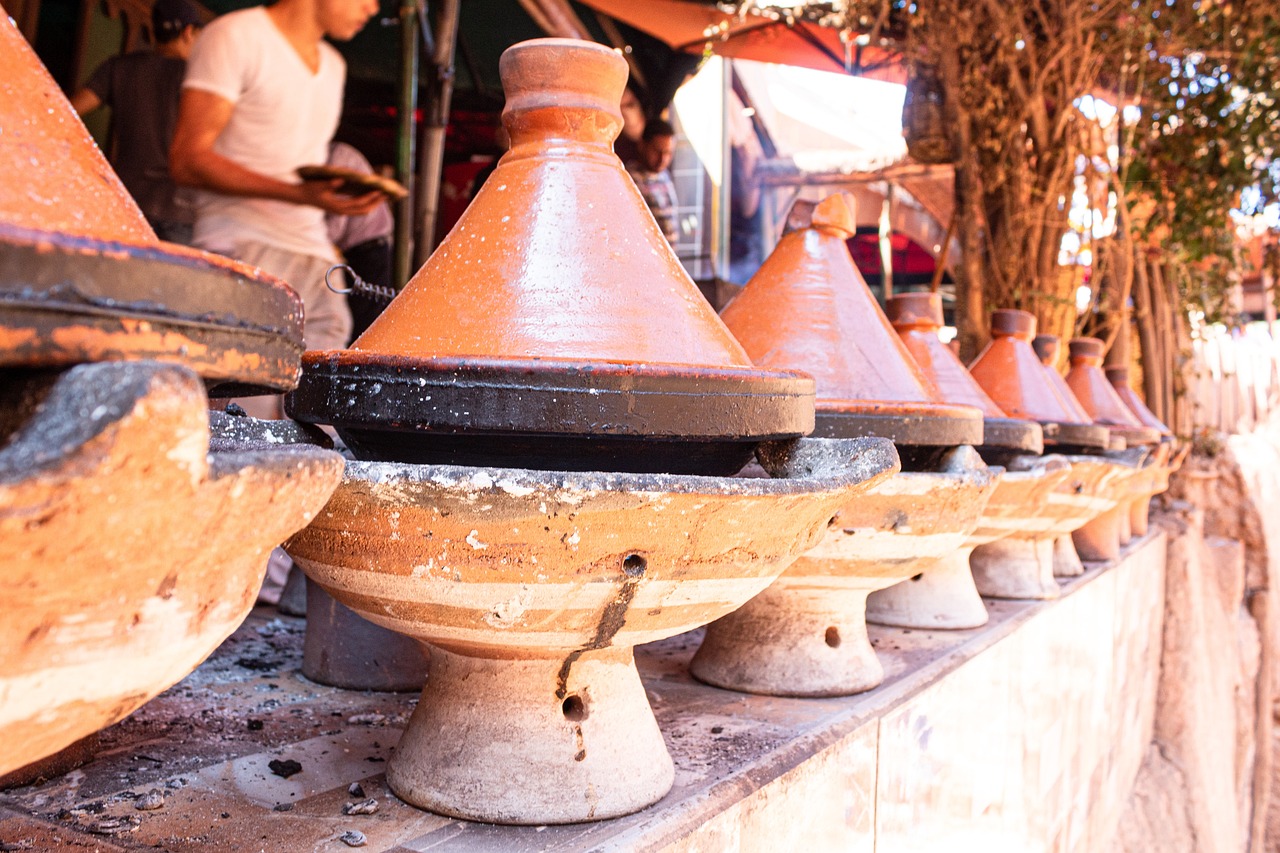Food in Morocco
While we were there, we sampled many different Moroccan dishes. Before visiting Morocco, we thought of Arab food as having intriguing flavors, combining eastern spices with meat and vegetables, aromatic tea varieties, and delectable fish. So what did we order, and what can one get in Moroccan cafes and restaurants? See this article for more information about Food in Morocco.
Couscous with meat and vegetables
In Europe, couscous is pricey and frequently regarded as an uncommon side dish. For example, in the Czech Republic, a kilogram of couscous will cost between 3 and 4 euros. Couscous is a typical Moroccan side dish that is used in a variety of regional specialties. Couscous is simply coarsely ground grits for those who are unaware.
Morocco’s national dish, couscous with veggies and a piece of meat, is the most often consumed variation of this side dish (chicken, cattle, lamb, or fish). Couscous can be prepared in a standard pot or a special pan called a tajine. Ceramic dish called a tajin has a conical top. The dish stews in a tagine and develops a subtle flavor. When the meal is prepared, the cover is removed, and a ceramic dish with couscous, coarsely chopped vegetables (turnips, carrots, and eggplant), bone-in meat, and flavorful seasonings is placed on top. Don’t you think it sounds delicious? If you prefer meat to couscous and want to eat well, it is unquestionably not in your best interests. This is due to the fact that such meals only employ 100 grams of beef.
Depending on how popular the location is, vegetarian couscous with meat can cost anywhere between 45 and 80 dirhams at Moroccan restaurants. My perspective is that I expected to discover vast quantities at such low prices in Africa.
Tagine
The term “tajine” refers to everything made in one, not merely a pot for stewing meat. Both the chicken, lemon, and olive, as well as the beef and prune tajines, were delicious (tajine de poulet au citron). Tajine is traditionally cooked over an open flame with the flavorings of spices, dried fruits, and olive oil. This meal can also be topped with slices of boiled egg or almonds and is served with pieces of Moroccan flatbread to sop up any sauce that may be left over.
Typically, Moroccan eateries only offer their menus in Arabic or French. If you don’t speak any of these languages, be sure to look up the translation of unusual foods in a dictionary to avoid having to eat tajine that has liver or giblets in place of meat.
A tagine may cost anywhere from Dh40 to Dh90 on average, depending on the fillings. For 85 dirhams, we enjoyed the most delectable and filling tajine at the Menara Mall in Marrakech. No matter where we tried it, a tajine with such a potent flavor was never again encountered. The worst tajine with liver we had ever had in Casablanca was at the Zayna restaurant in the new medina.
Shakshuka Kebab
A well-liked variety of kebab from Turkey has traveled to Morocco and is similar to our shish kebab. With fresh veggies and onions, these kebabs are frequently made with lamb or chicken. A shish kebab is an easy and quick snack. It is provided at the Food in Morocco sections of shopping malls and cafés along the highway. It frequently includes a tiny side salad of veggies and French fries. In a clean environment, the price of a portion of shish kebab with a side dish ranges from 60 to 70 dirhams.
Harira Poodle
Lentils, chickpeas, tomatoes, and meat broth are used to make the Moroccan soup known as harira. Along with the soup, two dates and a flatbread with mint are included. The soup’s ingredients can be blended together and either served whole or ground up before serving. When the soup is served, it is topped with lemon juice and occasionally bits of chicken or lamb. We found harira soup to be incredibly fatty and spicy, which may be why Arabs consume it when fasting during Ramadan. A bowl of harira soup will cost you between 6 and 8 dirhams.
Mint tea and Food in Morocco
The local mint tea, or thé à la menthe, is frequently referred to as “Moroccan whisky” due to how relaxing it is. Green peppermint tea is liberally sugared and then poured into a vintage teapot with a narrow spout. From a height, tea is poured into tiny glass cups, where it is oxygenated and foam formed. Throughout the meal, each participant sips tea made in a little kettle with mint. A cup of mint tea costs between 15 and 20 dirhams in the cafe.
For less than ten dirhams, a sizable bundle of dried mint may be obtained at Moroccan shops, and you can prepare a delicious cup of mint tea at home. Another issue is that the tea won’t be in factory packaging, which can raise suspicions among border customs authorities. But this is undoubtedly a joke. The alluring blend of mountain herbs in berber tea has a particular flavor and is sometimes served with dried mint.
Sweets Food in Morocco
Because the residents enjoy sweets, businesses dedicate entire sections to tiny packaged cookies. You can assemble a candy box yourself or buy one that has already been put together. In my recall, these sweets had a marzipan filling with a delicious almond and honey flavor. We brought them to Prague, but when we got there, we realized how much we had loved them in Morocco and how they had not evoked any unique feelings in us. It costs between 70 and 100 dirhams to purchase a kilogram of Moroccan sweets. Not a bad gift for individuals who enjoy sweets.
We sampled these sweets before visiting the Carrefour shop and purchased a dinner that included them for dessert at the beautiful L’Adresse café in Marrakech’s medina’s Djema el-Fna marketplace. A good guess would be around 70 dirhams.
We were really happy with the candies being sold by the Paul’s brand of candy stores in Morocco. They were significantly superior to what we had become accustomed to in Prague. 55 dirhams can buy you a lovely raspberry tartlet and a cup of coffee in Marrakech.
Oranges in season and pomegranates
Morocco has long been viewed as an orange paradise. Oranges are delicious in this location, as is their freshly squeezed juice. We did not try any of the fresh fruit being sold on the streets because of the unsanitary conditions in some locations, but for 15 to 20 dirhams, you can purchase a fresh fruit plate in any café or restaurant that is composed of the most beautiful oranges. We requested that no ice be added to the juice because Moroccans manufacture ice using subpar flowing water.
In addition to orange juice, pomegranate juice is also sold on Moroccan streets for only 10 dirhams. We weren’t interested in the tiny, pink native pomegranates. But the Turkish pomegranates that were imported were so exquisite and almost dripping with juice that we brought a few back to Prague.
The strange thing is that you occasionally see carts of cacti at Moroccan medina markets. Before plucking a lovely red fruit, the dealer uses protective gloves to clean the cactus in front of you. Here, the major goal is to keep from getting soiled.
Arabic-style fast food in Morocco
In Morocco, convenience foods and street food were helpful, particularly as our vacation was coming to a conclusion and the traditional tagine was no longer an option. Burgers, pizza, and spaghetti are common fast food options. We tried some meat-filled pizza and pasta in the mall in Fez but weren’t impressed, so we placed more orders. It was amusing because even after two servings of pasta, we still felt hungry.
The Blend restaurant, which was adjacent to the Casablanca apartment we were renting, served very succulent and tasty hamburgers. A good hamburger with meat at McDonald’s costs between 40 and 50 dirhams. For 200 dirhams, two people can eat and drink a delicious meal of hamburgers.
We never went inside any of the local fast food joints. The interior was horribly disorganized and dirty. Typically, the prices of these cafés’ sandwiches, pizza, burgers, and shawarma range from 20 to 45 dirhams. Such areas are immediately identified by their overpowering stink, which can be heard from a mile away.
Sea dishes Food in Morocco
We avoided seafood when visiting Morocco because it was only available in eateries managed by foreigners and we preferred to eat real native cuisine. The cost of seafood always astounded me when I visited the fish counters in the Acima and Carrefour supermarkets. A large box of shrimp weighing at least 2.5 to 3 kilos costs less than 20 euros in the adjacent Canary Islands, whereas a kilo of little shrimp costs about 14 euros in the city. In Morocco, local markets are thought to be the only venues to buy affordable fish, contrary to popular opinion. However, no one will ever tell a visitor the full price. And be prepared to pay more if you want to purchase fish from a store normally.
local dating opportunities
Like many other southern countries, Morocco also cultivates dates. We sampled a variety of dates, including those that were sold for 180 dirhams per kg at the supermarket, 120 dirhams per kg at the medina bazaar, and 40 dirhams per kg at a small kiosk close to the house. The most costly ones, which were particularly syrupy and juicy, would have made a terrific substitute for candy. However, the cheaper ones didn’t cause any particularly noteworthy commotion. In addition to Moroccan dates, the market also offers dates from Tunisia.
Bread
Because it is obvious from observing Moroccans that they are poor, I got the impression that bread was the major dish on the Moroccan table. However, I was once more unimpressed when I tried different types of bread in Morocco. Every loaf of bread, whether it was a baguette from a European shop, bread served during lunch at a restaurant, or bread bought at the market, was rubbery and unpleasant. Diners frequently receive tortillas from Morocco. Food in Morocco markets usually carry them.
Moroccan Liquor
Morocco’s access to alcohol is restricted, same like in other Arab countries. The only places to find it, meanwhile, are in specialized liquor stores or retail malls constructed in expat districts apart from mosques.
We were delighted to find a number of good local wines, especially the reds. The wines are made here using French technology, and European professionals are heavily involved in the process. For a 0.75 liter bottle, you could anticipate paying between 55 and 100 dirhams. Morocco is the only country where “vino gris,” a rare grey wine, is offered. We tried it, but nothing about it stood out to us.
In addition to wine, Morocco also makes beer. We had access to just Casablanca Premium beer. A 0.33 liter bottle costs roughly 15 dirhams at a specialty alcohol store. The drink was found to be a simple light beer without any extra flavors or aftertaste. So we made the decision to sip on some red wine and enjoy the evening.
Finally, I should mention that we had higher expectations for Moroccan cuisine. It lacks many of the qualities of Mediterranean food and cannot be compared to the neighbouring Canary Islands’ cuisine. Although we haven’t confirmed it, tourists claim that the seafood in the seaside vacation town of Agadir is better than that found across the rest of the country. We were let down by European eateries’ exorbitant rates and meager portions. Have you ever sampled Food in Morocco?

